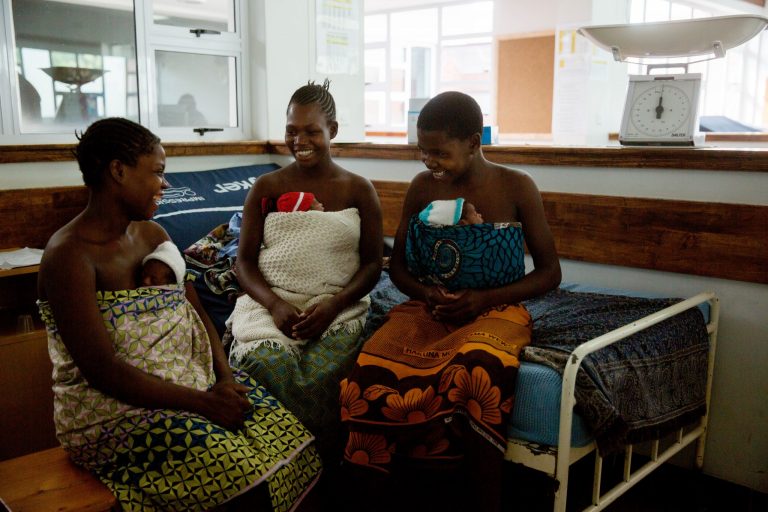One of the youngest members of our family arrived earlier than expected. I caught a glimpse of his tiny head lying on his dad’s chest while I Skyped with my aunt in Bogotá, Colombia. She told me that she and her husband were taking turns holding their baby, Jorge, against their bare chests – a practice known as skin-to-skin contact. Skin-to-skin, exclusive breastfeeding, and regular follow-ups are all elements of the kangaroo mother care program that Jorge was initiated on at the hospital and was now continuing at home.
Over the following months, my aunt kept me posted about Jorge’s progress. Like Jorge, Jimena – born a few years later to my other aunt – was initiated on kangaroo mother care because her growth had stunted at 13–16 weeks of gestation and she weighed only 1,900 g (4.2 lbs) at birth. For the first month, Jimena’s parents worked to keep her on skin-to-skin for over 20 hours a day and took her for daily follow-ups to check on her weight and overall development.
However, kangaroo mother care, or KMC, takes more than hopeful mothers to practice skin-to-skin, breastfeed, and take their babies to follow-up appointments. KMC is not a low-cost or easy-to-implement DIY intervention. You need skilled health workers, supplies, and space. And even when these basic requirements are met, sociocultural barriers may remain, including lack of enthusiasm from family and healthcare providers. Perhaps this is why, despite strong evidence that KMC can significantly reduce morbidity and mortality in preterm infants, scale-up of KMC continues to lag, especially in countries with high neonatal mortality rates.
In 2013, a group of about 70 organizations established the KMC Acceleration Partnership, or KAP, with the goal of increasing global coverage of KMC to 50 percent by 2020. Through investments, knowledge sharing, and technical support, the KAP has brought together ministries of health, healthcare providers, and representatives from partner organizations. Efforts have focused on seven priority countries: Bangladesh, India, and Indonesia in Asia; and Ethiopia, Malawi, Nigeria, and Rwanda in Africa. The KAP also supports other countries, like China, where adoption of KMC is just starting.
In October 2017, delegates from 10 countries, UNICEF, WHO, USAID, and Save the Children convened in Blantyre, Malawi, for the annual KMC Acceleration Partnership (KAP) Community of Practice meeting to share lessons learned, challenges, and plan next steps for 2018. There were rich discussions about how countries in the early stages of KMC adoption could integrate KMC as a standard intervention for small babies, while countries that have a longer history implementing KMC exchanged strategies to ensure quality of care and sustainability.
Malawi, which hosted the meeting, has the highest rate of preterm birth worldwide. However, the Ministry of Health, with the support of partner organizations, has instituted policies and strategies that prioritize the care of small and preterm newborns. Some strategies include use of social behavior change communication (SBCC) campaigns to address social norms that undervalue preterm and low birthweight babies, improving documentation to track and treat newborn conditions, and a clinical mentorship program for improving quality of KMC and care to small newborns.
As meeting participants, we were impressed to witness optimal KMC practices at the Thyolo District Hospital, Mulanie Mission Hospital, and Queen Elizabeth Central Hospital. We were in the company of local KMC champions who – with the support of the ministry – have successfully promoted increased access to KMC. Specifically, we noted good record-keeping across facilities, the use of data to improve the management of small babies, adequate space designated for KMC, and the assignation of a nurse to each KMC unit to coach mothers and perform post-discharge follow-up.
Each country developed and presented its own action plan for 2018 to continue improving KMC practices. Some action points were similar across countries, such as collaborating with professional associations to raise visibility and integration of KMC and family-centered care practices, supporting the establishment of more KMC spaces within health facilities, improving reporting practices and data use, and strengthening post-discharge follow-up. The action plans of the four observer countries (China, Myanmar, Kenya, and Uganda) focused more on advocating for stronger commitment from government and partners, promoting KMC as an evidence-based intervention, and adopting and tailoring tools used in other countries.
Participants agreed there is a need to prioritize the care of mothers, as they are vulnerable to post-partum depression and often struggle to provide intermittent KMC when they are discharged while their babies remain in the NICUs. Tied to this point, delegates highlighted family-centered care as an approach to care for hospitalized preterm and low birthweight babies while engaging caregivers, reducing family separation, and improving care of mothers.
Care of preterm and low birthweight babies has gained momentum in several countries, and we see support of these efforts by organizations such as WHO, which will soon release Baby-Friendly Hospital Initiative (BFHI) guidelines that focus on the care of small and sick babies. It is critical that countries, with the support of partners, hone in on quality, sustainability, and innovation for maternal and newborn care. This means continuing the scale-up of KMC hand-in-hand with improving counseling on breastfeeding, preventing and managing hypothermia, advocating for a family-centered approach, and using data as a tool for course correction.
Jorge and Jimena both reached healthy weights and are developing normally, but not all babies are so fortunate. Fifteen million babies are born prematurely each year, and 1 million children under age 5 die from causes related to preterm birth. We need to do more, including efforts like the KAP, to ensure that all babies like Jorge and Jimena and their parents and caregivers, receive the care and support they need to survive, thrive, and reach their full development potential.
Featured image: mothers at the neonatal ward at Queen Elizabeth Hospital, Malawi. Photo by: Save the Children.

